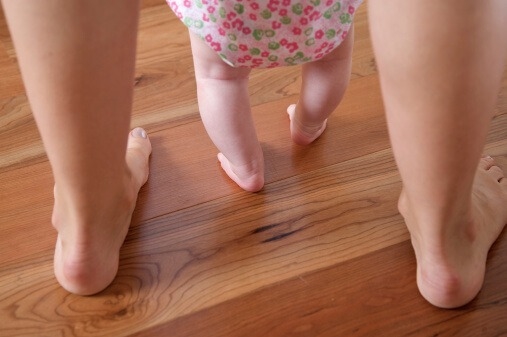
Bow Legs In Children – Signs, Causes And Treatment
5 Apr 2019 | 5 min Read
Revati Narayanswamy
Author | 52 Articles
All babies have a slight bow in their legs when they are born. This is due the position of the baby in the mother’s womb. Their leg starts getting back to normal by the time the baby is 3 months old. When the baby reaches his 7th or 8th month and starts attempts to walk, the bow leg starts disappearing altogether. By the child’s 3rd birthday, his legs look as normal as any other person.
Sometimes, bow legs are caused by a deficiency of Vitamin D (rickets) or a condition which is known as Blount’s disease. It is a bone disorder which affects the shins. This condition may also be genetic.
Signs of a bow leg
As mentioned above, every baby is born with a bow leg as they take that position in the uterus and the space issue makes them adjust their body and since their bones are soft, it takes that form. However, there are some signs which you need to look out for to determine if your baby has the condition.
- If your baby’s knees don’t meet while standing straight while the feet and ankle meets, then he has bow legs.
- Every baby is bowlegged when they are born but, if their legs do not straighten out by toddlerhood then your child has bow legs.
- If the child’s walking pattern is awkward.
- There is a coordination problem during the movement of the baby.
- Pain or discomfort.
Always look at your baby’s position when he is standing upright to determine if his legs are bowed.
Causes of bow legs
Apart from the position in the womb, some causes of bow legs are:
- An extreme curve in the child’s legs.
- The baby feels pain when he makes attempts to walk.
- Has an issue in advanced movements.
- Faces trouble while trying to stand upright.
- Blount’s disease – a bone disorder condition wherein the shin bone is affected.
- Rickets – a disorder which affects growth in children cased due to the deficiency of Vitamin D.
- Bowing fractures – this is mostly a temporary condition where there is swelling and pain and the bone only bends and does not break.
When should you see a doctor?
You should be taking your child for a diagnosis to a pediatrician when:
- Your baby’s legs are prominently bent even after his third birthday.
- The issue crops up in only one leg and it only seems to be increasing that getting better.
- The child has knee or hip pain and he hasn’t hurt or injured himself.
- Your baby is facing difficulty in walking or if he complains of knee and hip pain or pain in his legs for no apparent reason.
Aside from these pointers, if you have the slightest doubt that your baby is bow legged then please do make it a point to consult your doctor. There is no harm in getting validation from a medical practitioner.
Diagnosis of bow legs
The doctor usually knows if a child has bow legs by just looking at his legs. Apart from this if he too has his doubts, he will conduct these tests on the child.
- The doctor will measure the separation distance between the child’s knees when the child is lying on his back.
- There will be tests to determine if there is an insufficiency of Vitamin D or calcium.
- The doctor will advise a few x rays to see if there is any problem in the bone development or to see if there is any sign of Blount’s disease.
- The doctor will also conduct some more tests to rule out the possibilities of diseases like rickets.
Treatment for bow legs
If your child is detected with bow legs, these are the following things which will be done for his treatment:
- If the condition is caused to due rickets then an adequate amount of Vitamin D intake could rectify the problem without the need for surgery.
- If the child is affected by Blount’s disease then bracing of the legs is done to rectify the condition.
- In extreme cases where no line of treatment is working and even bracing isn’t helping, a surgery may need to be conducted to rectify the problem.
- The growth and development of the child will be monitored every six months to see if the situation is improving.
It is very important to consult a doctor if you spot any signs of bow legs in your child as untimely treatment or a lack of treatment may lead due to severe complications like deformities in the child’s legs. The child may also face major problems later in his life while performing advanced movements like running and the child may be at a higher risk of arthritis in his knees and hips during the later stages of his life.
If you have the slightest doubt that your child has bow legs, consult a doctor and get your doubt cleared.
Banner Image: drgreene
Also read: How To Identify Flat Feet In Children?
A


Related Topics for you
Suggestions offered by doctors on BabyChakra are of advisory nature i.e., for educational and informational purposes only. Content posted on, created for, or compiled by BabyChakra is not intended or designed to replace your doctor's independent judgment about any symptom, condition, or the appropriateness or risks of a procedure or treatment for a given person.
